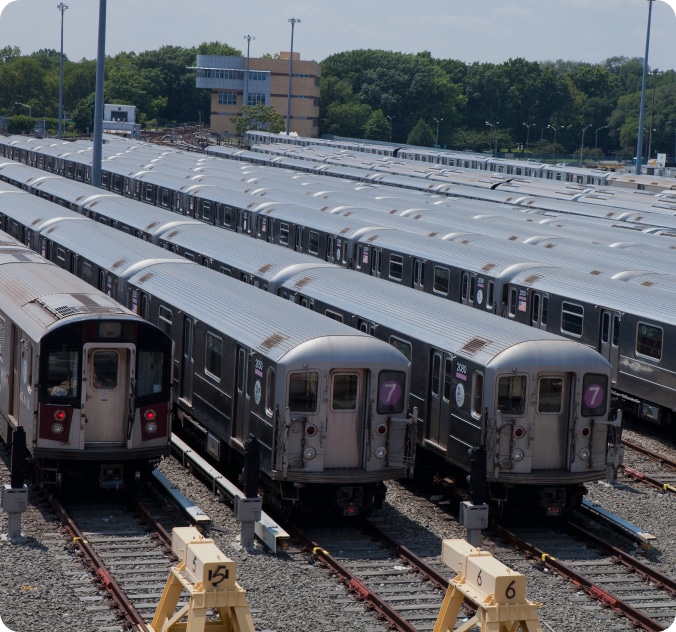Join us at AREMA, Indianapolis – Sept 14-17
General Info
Multi-sensor Automatic Train Protection.
Agencies have several options for the design of safe train control systems depending on the operational requirements of the system. For many urban transit operators, Communication Based Train Control (CBTC) is an appropriate choice. However, CBTC deployments are costly and have complex schedules for installation for many reasons.
For lines that do not rise to the CBTC level of requirements, agencies may choose a design based on signal protection that relies on traditional signaling with additional safety functions provided in an overlay design in order to upgrade and achieve SIL-4 operation. This approach is similar to how Positive Train Control (PTC) operates.

ATP-Overlay Solution
What is ATP-O?
The Piper Rail Positioning System (RPS) is capable of helping agencies achieve their modernization goals without incurring the cost or disruption involved in the commissioning of CBTC.
Doing so requires implementing a system that can be added to existing infrastructure to improve overall safety and reliability. We refer to this as the ATP Overlay (ATP-O) approach because it assumes retention of a signaling system in order to meet the IEEE functional ATP requirements of CBTC at a reduced cost and with minimal disruption.
At a high level, ATP-O is a design approach that uses Piper’s RPS system identically as it’s deployed for CBTC for vital position and speed. But it’s expanded to include integrations with existing critical signaling equipment and with the addition of Piper’s carborne Safety PLC to initiate braking when an operator ignores one or more protection rules. The result is a comprehensive and convenient system that is competitive with the benefits of full CBTC.
Among the examples for this type of integration are:
- Solid State Interlocking (SSI) — to receive and process switch position to determine safe operation.
- Signal Heads — to determine and display signal aspect to the operator.
- Grade Crossing Controllers — to improve the reliability of train detection near grade crossings.

Among the examples for this type of integration are:
- Solid State Interlocking (SSI) — to receive and process switch position to determine safe operation.
- Signal Heads — to determine and display signal aspect to the operator.
- Grade Crossing Controllers — to improve the reliability of train detection near grade crossings.
With ATP-O, agencies can benefit from the ability of trains to communicate directly with wayside equipment while operating in the territory.
In addition to determining vital speed and positioning information, Piper is capable of integrating UWB radios into various wayside devices and including the data in critical train control calculations while also displaying the information to the operators.
System Components

LiDAR
Light Detection and Ranging (LiDAR) units are mounted to vehicles to detect objects and workers in the path.
LiDAR
Light Detection and Ranging (LiDAR) units are mounted to vehicles to detect objects and workers in the path.
Ultra Wideband (UWB) Anchors and Tags
Precision location of vehicles and collision avoidance.
Ultra Wideband (UWB) Anchors and Tags
Precision location of vehicles and collision avoidance.
Operator Displays
In-cab displays communicate vital information to the operators like speed, approaching grade crossings, and distances to work zones.
Operator Displays
In-cab displays communicate vital information to the operators like speed, approaching grade crossings, and distances to work zones.
Time-of-Flight Cameras
TOF cameras have a variety of uses including detection of track intrusions at stations.
Time-of-Flight Cameras
TOF cameras have a variety of uses including detection of track intrusions at stations.
GPS RTK
Base stations are installed throughout the territory and provide vehicle locations within centimeters.
GPS RTK
Base stations are installed throughout the territory and provide vehicle locations within centimeters.
Testimonials
Proven in the field
Benefits
Uses for ATP Overlay
Train Speed Determination
The system is independently SIL-4 certified for position and speed.
Rollback Protection
The system detects small fluctuations in train movement and enforces a brake action.
Departure Interlocks
Interfaces with door control to ensure zero speed, door alignment, and platform side assurance.
Coupling & Decoupling
The system measures the consist length and provides alerts/brakes in the event of a decoupling.
Work Zone Protection
Piper’s navigation computer can be updated with TSRs and work zone location and enforce protection rules.
Safe Train Separation
Location awareness in the territory combined with P2P communication ensures safe train separation at all times.
Overspeed Protection
Vital speed determination can be integrated with Piper’s Safety PLC to provide graduated speed control or emergency braking.
End-of-Track Protection
Provides positioning throughout the territory, including track limits. Protection for this function is similar to that for red signals.
Emergency Braking
Integration with Piper Safety PLC provides emergency braking functionality that can be activated in response to breach of several protection rules.
certification
SIL4 Safety Certified

Piper’s news
Other Solutions
Reliably Innovative Transit Solutions
Piper has an existing suite of real-time location systems (RTLS) solutions that utilize various technologies, including: UWB, BLE, GPS-RTK, LTE, RFID, HD Cameras and LiDAR.

Maintenance of Way Safety
Piper’s multi-sensor MOW safety solution provides limits compliance, collision avoidance and detection, and greatly improves track worker safety.
Learn more
Train Navigation
Determine the location of trains with unmatched positional certainty, even underground or on elevated tracks in the city.
Learn more
Grade Crossing Safety
Monitor grade crossings remotely to detect occupancy and alert rail system operators to potential hazards.
Learn moreOur single platform is not only designed to communicate seamlessly with your existing systems, but they can also be interoperable with your legacy equipment. Use Piper’s proven solutions to improve efficiencies and safety, or contact us to develop something specific to your requirements.

Station Safety & PIDS
Calculate train arrival/departure times to improve rider experience, and keep them safe on the platforms with special track intrusion cameras.
Learn more










